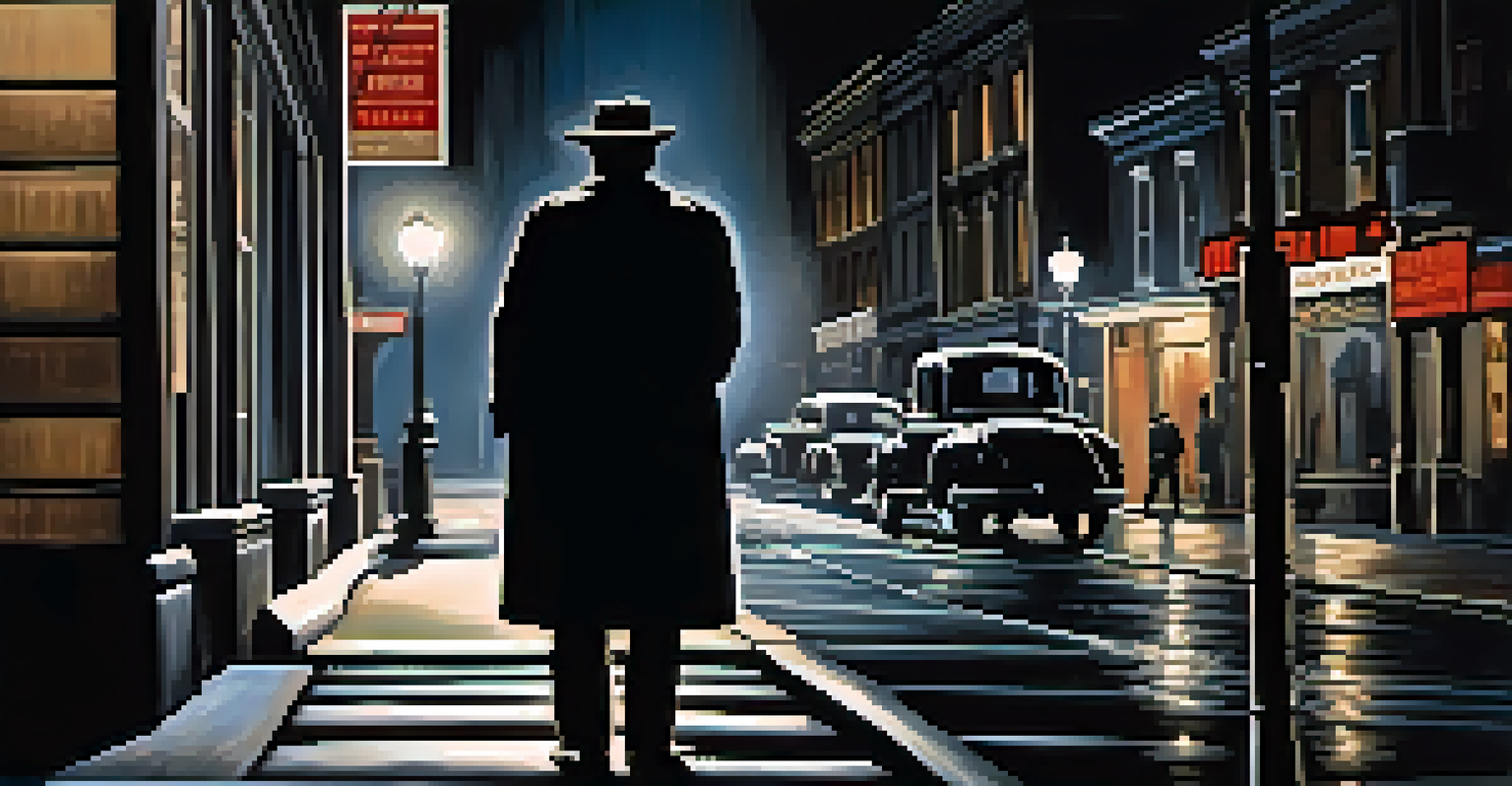Exploring the Impact of Lighting on Film's Emotional Depth

Understanding the Basics of Film Lighting Techniques
At its core, film lighting is about more than just visibility; it sets the mood and tone of a scene. When filmmakers choose specific lighting techniques, they can manipulate how the audience feels about a character or situation. For instance, high-key lighting often creates a cheerful or optimistic atmosphere, while low-key lighting can evoke tension and mystery.
Lighting is a way to make the invisible visible.
Imagine watching a romantic comedy lit with bright, soft lights that make everything look warm and inviting. Contrast this with a horror film where shadows loom large, and harsh lights create an unsettling ambiance. These choices aren’t random; they are intentional techniques that filmmakers use to guide viewers' emotional responses.
Ultimately, understanding these basics allows us to appreciate the artistry behind film. It’s not just about what we see on screen; it’s about how we feel while we watch. Lighting is the unsung hero that enhances the narrative, helping to build emotional depth and connection.
The Psychology of Light: How It Influences Emotions
Lighting plays a crucial role in shaping our emotional experiences, tapping into psychological responses that we often don’t consciously recognize. Bright, well-lit scenes can evoke feelings of happiness and safety, while dim lighting may incite feelings of fear or anxiety. This psychological impact is something filmmakers harness to create a desired emotional landscape.

Consider how a film might switch from bright daylight to a dimly lit room, immediately signaling a shift in tone. This transition can heighten tension or highlight a character's internal struggle, guiding the audience's emotional journey. The colors and intensity of light can even evoke specific memories or associations, further deepening the emotional experience.
Lighting Sets Mood and Tone
Film lighting is crucial in shaping the emotional atmosphere and guiding audience reactions to characters and situations.
By leveraging these psychological aspects, filmmakers can craft powerful narratives that resonate on a deeper level. The lighting choices made during filming become a language of their own, communicating emotions that words sometimes cannot express.
Examples of Iconic Films That Use Lighting Effectively
Many iconic films demonstrate the profound impact of lighting. Take 'Blade Runner,' for example; its neon lights and stark contrasts create a dystopian world that feels both beautiful and haunting. The lighting choices in this film not only establish the setting but also enhance the emotional weight of the characters’ struggles.
The light is what guides the viewer's eye and shapes their emotional response to the narrative.
Similarly, in 'The Godfather,' the use of shadow and light during key scenes conveys power dynamics and moral ambiguity. The dimly lit interiors reflect the hidden secrets and complexities of the characters, inviting viewers to ponder their motivations and choices. This masterful use of lighting adds layers to the storytelling.
These examples highlight how lighting can elevate a film from mere entertainment to a profound emotional experience. By examining these films, we can gain insight into how lighting shapes not just the visual elements, but also the emotional depth of the narrative.
The Role of Color in Lighting and Emotion
Color is another vital aspect of lighting that contributes to a film's emotional depth. Different colors evoke different feelings; for instance, warm colors like reds and oranges can create a sense of comfort or passion, while cooler colors like blues and greens might evoke calmness or sadness. Filmmakers often use these colors strategically to influence audience emotions.
Think of how a sunset scene bathed in orange and pink hues can elicit feelings of nostalgia and warmth, while a cold blue light might evoke isolation or despair. This interplay of color and light can add richness to the storytelling, making scenes feel more vivid and relatable.
Color Influences Emotional Depth
The strategic use of color in lighting can evoke a wide range of emotions, enhancing the storytelling experience.
By understanding how color works with lighting, viewers can appreciate the emotional subtleties that filmmakers weave into their narratives. It’s a reminder that every visual choice is made with intention, working together to create a holistic emotional experience.
Lighting as a Character: The Influence of Light on Story
In many films, lighting can almost act as a character in its own right, influencing the narrative and the characters' journeys. The way light interacts with the setting and characters can symbolize internal conflicts or foreshadow events. This dynamic relationship between light and story is a powerful storytelling tool.
For instance, in 'Schindler's List,' the stark contrast of light and dark not only highlights the horror of the Holocaust but also emphasizes moments of hope and humanity. The use of a single red coat in an otherwise black-and-white scene serves as a poignant reminder of innocence amidst tragedy.
By treating lighting as an integral part of the storytelling process, filmmakers can create deeper connections between the audience and the narrative. It becomes a visual metaphor, enriching the emotional layers of the film and inviting viewers to engage with the story on a more profound level.
The Evolution of Lighting Techniques in Film History
The techniques used for lighting in film have evolved significantly over the years, shaped by technological advancements and artistic movements. Early films relied heavily on natural light and basic setups, which often limited the emotional range they could convey. However, as technology progressed, filmmakers gained the ability to create more nuanced and dynamic lighting effects.
For example, the introduction of colored gels and sophisticated lighting rigs allowed for greater creativity, enabling directors to experiment with mood and tone. This evolution has led to iconic lighting styles seen in films like 'Casablanca,' where soft lighting enhances the romantic atmosphere, or 'Citizen Kane,' which uses chiaroscuro to build tension and drama.
Lighting as a Storytelling Tool
In many films, lighting serves as a powerful narrative element, symbolizing internal conflicts and enriching the viewer's emotional engagement.
Understanding this evolution helps us appreciate the artistry involved in modern filmmaking. Today, lighting is a highly specialized craft that plays a pivotal role in storytelling, allowing filmmakers to explore emotional depths that resonate with audiences worldwide.
Future Trends: The Next Frontier in Film Lighting
As technology continues to advance, the future of film lighting holds exciting possibilities. Innovations such as LED technology and digital lighting control offer filmmakers unprecedented flexibility in creating mood and atmosphere. These advancements allow for real-time adjustments during filming, making it easier to achieve the desired emotional impact.
Additionally, virtual reality and augmented reality technologies are beginning to influence how filmmakers approach lighting. With immersive experiences becoming more prevalent, lighting will play a crucial role in enhancing the audience's emotional journey within these new formats. Imagine being enveloped in a scene where the lighting shifts dynamically to reflect your character's emotional state!

As we look ahead, it’s clear that lighting will remain a vital component of filmmaking, continually shaping how stories are told and felt. By embracing new technologies and techniques, filmmakers will push the boundaries of emotional storytelling, ensuring that the impact of lighting continues to evolve and inspire.